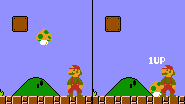Extra life
An extra life (also known as a "1-Up", "1-UP" or "1UP") is a term used in video games, especially platforming games, such as those in the Mario series. A 1-UP awards the player with an extra chance to beat the game. If a player dies, they will be able to start unscathed from the beginning of the level (or sometimes, at the level's mid-point, if it has been reached). When a player loses all of his/her lives, the result is a Game Over, and the game must either be played again from the beginning, or be restarted from the last save point. Players can lose lives by being defeated by an enemy, falling into an abyss, or falling into lava or poison water. In most Mario games, players typically start with three to five extra lives, and can usually earn more during the course of the game. A six-note tone, containing the notes E,G,E,C,D,G in that specific order, has always been heard when a Mario game character has received an Extra life.
As of Super Mario Bros. 3, the maximum number of lives Mario or Luigi can typically obtain is 99. In some more recent games, he can have up to 1,110 (represented by three crowns).
Early arcade games, such as Donkey Kong, typically awarded an extra life after a large number of points was acquired by the player. However, the 1-UP independent of score did not emerge until the original Super Mario Bros. In this game, the 1-Up Mushroom was introduced. This special item merely needed to be collected to reward the player an extra life. However, these items were typically hidden and were very hard to acquire. This trend continued in other platforming and adventure games, and as such, extra lives were often seen as the ultimate bonus of early gaming. Examples of life-giving items include the 1-Up Mushroom and 3-Up Moon.
Super Mario Bros. also introduced another concept associated with 1-Ups – collection of one hundred objects. In the game, if one hundred coins are collected, the player is rewarded with an extra life. In many platforming and adventure games, collecting one hundred of a specific item granst a 1-Up (such as in the Donkey Kong Country series, where collecting one hundred Bananas yields an extra life). The game Super Mario 64 alters this formula - only fifty coins are needed for a 1-Up, while collecting one hundred gives the player a Power Star. The extra lives from collecting coins only registers if one of the regular stars in the level are collected. In other games, a low number of items can be collected for an extra life. These include the Dragon Coins of Super Mario World, where five coins gives an extra life, and the K-O-N-G Letters of the Donkey Kong Country series, where all four letters grant a 1-UP, but only if a complete set is acquired in a single level, unlike coins and bananas, which have a running total throughout the game. Some games also feature items that award more than one extra life, such as the 3-Up Moon from Super Mario World and New Super Mario Bros. U, and the various colored Extra Life Balloons of Donkey Kong Country, which yield a different amount of extra lives based on color. In some games, 1-Ups award full health, such as in Super Mario 64 and Super Mario Sunshine.
Extra lives can also be obtained by jumping on each enemy consecutively without touching the ground. As the player jumps on each enemy, they earn points. After the player jumps on the eighth enemy, they earn an extra life. This technique can be used in most of the 2D Mario games, and in 3D Mario games on the Yoshi planet in Space Junk Galaxy in Super Mario Galaxy and the Giant Koopas planet in the Supermassive Galaxy in Super Mario Galaxy 2 (Except in these games and Super Mario 3D Land, the player does not earn points but still earns an extra life after jumping on the eighth enemy in Super Mario Galaxy and Super Mario Galaxy 2 or fifth enemy in Super Mario 3D Land).
Mario games with cooperative multiplayer have used different life systems. In games such as Mario Bros. (and all its ports), New Super Mario Bros. Wii and New Super Mario Bros. U, each player has their own life counter, though in New Super Mario Bros. 2 and Super Mario 3D World each player shares the same life counter (though in the case of Super Mario 3D World the life counter has a combined total depending on the number of players rather than starting at five.
Extra lives are only surpassed by the "Continue", which grants an entire new set of extra lives, instead of just one.
In Paper Mario: The Thousand-Year Door, when Bowser is going through the Super Mario Bros.-style levels, he has an infinite amount of lives.
Trivia
- "1UP" can be seen in a license plate of a truck in the Mario Kart: Double Dash!! course Mushroom City.
- According to Super Paper Mario, when someone runs out of extra lives, they will get a Game Over and move on to the afterlife, either to The Underwhere or The Overthere.
- In Super Mario World, if the player somehow manages to jump on enemies more than 8 times in a row, the game will show 2UP, 3UP and then the game glitches: it shows corrupted sign that grants 5UP (first only) and some Coins and/or Points.
